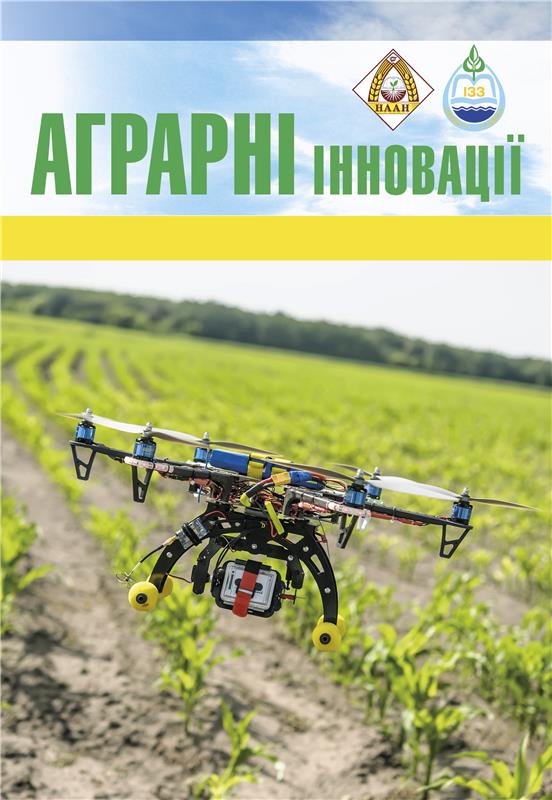FORMATION OF PRODUCTIVITY TRAITS OF SOFT WINTER WHEAT IN THE NORTHERN SUBZONE OF THE STEPPE OF UKRAINE
Abstract
Determining the variability of quantitative traits and the pattern of inheritance of quantitative traits of parental forms and F1 hybrids is one of the crucial steps to successful breeding. Purpose. The aim of the study is to determine the features of the main environmental aggregates as a background for selection for productivity traits and comparison of first generation (F1) hybrids and parental forms, to establish variability and phenotypic dominance of morphometric and economically valuable traits of winter bread wheat varieties and hybrids in the northern subzone of the Steppe of Ukraine. Methods. The first generation (F1) hybrids and parental forms were analysed for morphometric and economically valuable traits such as length of vegetation period, spike length, number of spikelets, grains in spike, spike weight, weight of grain per spike, weight of thousand grains and determination of variability of these parameters, and determination of inheritance of yield and structural elementsin first generation winter bread wheat hybrids by the degree of phenotypic dominance (hp). Results. The results of the study revealed different variability of productivity traits in parental forms and hybrids of the first generation, the best parental forms and F1 hybrids were identified, different inheritance patterns in F1 hybrids were also established, and the best combinations with the type of inheritance of positive superdominance and positive dominance were identified, which may be of breeding and practical value. Findings.The first-generation hybrids showed an increase in almost all indicators by 2.37–15.82% compared to the parental forms, the best combinations were Palitra× Oleksiivka, Palitra×KSW 34, Bohynia×KSW 34, Bohynia×KSW 34 and Boginya×Oleksiivka and were distinguished by their productivity, with stable manifestation of positive dominance and superdominance, and the most common type of inheritance was positive superdominance (heterosis), which is found in all indicators of the yield structure.
References
2. Бакуменко О. М., Власенко В. А. Гетерозис та успадкування маси 1000 насінин в F1 пшениці м’якої озимої (Triticum aestivum L.). Автохтонні та інтродуковані рослини. 2015. № 11. С. 67–73. ISSN 2220-1114.
3. Zewdu D., Dabi A., Duga R., Alemu G., Geleta N., Sime D., Delesa A., Solomon T., Zeyaye H., Negash T., GetamesayA .,A snake D.,A sefa D., Tadesse Z., Shewaye Y. Bread wheat (Triticum aestivum L.) variety development, release and registration for rainfed areas of Ethiopia. Global Journal of Research in Agriculture & Life Sciences, 2024, 4 (6), P. 83–98.
4. Meshal M. A. Genetic parameters estimation for some wild wheat species and their F1hybrids grown in different regions of Saudi Arabia. Saudi Journal of Biological Sciences, 2022, 29, P. 521–525. DOI:10.1016/j. sjbs.2021.09.015
5. Hossain A., Skalicky M., Brestic M., Maitra S., Ashraful Alam M., Syed M. A., Hossain J., Sarkar S., Saha S., Bhadra P., Shankar T. Consequences and mitigation strategies of abiotic stresses in wheat (Triticum aestivum L.) under the changing climate. Agronomy, 2021, 11 (2), P. 241. https://doi.org/10.3390/agronomy11020241
6. Fareed G., Keerio A. A., Mari S. N., Ullah S., Mastoi A. A., Arain M. A., Adeel M., Shah M. A., Mengal A. M., Badini, M. I. Estimation of hetrosis in F1 hybrids of bread wheat genotypes. Journal of Appleid Research in Plant Sciences, 2024, 5 (1), P. 120–123. DOI:10.38211/joarps.2024.05.169
7. Ocaktan H., Güngör H., Dumlupinar Z. Heterosis and diallel analysis of yield and yield components of bread wheat F1 generation. Black Sea Journal of Agriculture, 2024, 7 (4), P. 363–376. DOI:10.47115/ bsagriculture.1479163
8. Kaur S., Kaur J., Mavi GS., Dhillon GS., Sharma A., Singh R., Devi U., Chhuneja, P. Pyramiding of high grain weight with stripe rust and leaf rust resistance in elite Indian wheat cultivar using a combination of marker assisted and phenotypic selection. Front Genet, 2020, 11:593426. https://doi.org/10.3389/fgene.2020.593426
9. Rangare N. R., Krupakar A., Kumar A., Singh S. Character association and component analysis in wheat (Triticum aestivum L.). Electronic Journal of Plant Breeding, 2010, 1, P. 231–238.
10. Fetahu S., Rusinovci I., Aliu S., Zeka, D. Inheritance of spike mass in F1 generation in wheat dependingon parents genetic diversity. Conference of Agriculture Sciences section, 2019, P. 62–64. DOI:10.13140/ RG.2.2.10998.34886
11. Fetahu S., Rusinovci I., Aliu S., Zeka, D. Determination of heterosis and heterobeltiosis for plant height and spike grain weight of F1 generation in bread wheat. International Journal of Ecosystems and Ecology Sciences, 2015, 5 (3), P. 431–436.
12. Adhikari A., Ibrahim M. A. H., Rudd J. C., Baenzinger S., Easterly A., Garts N., Belamkar V., Sarazin, J. B. Supplementing selection decisions in a hybrid wheat breeding program by using F2 yield as a proxy of F1 performance. Euphytica, 2020, 216 (8), P. 42. DOI:10.1007/s10681-020-02664-0
13. Dedaniya A. P., Pansuriya A. G., Vekaria D. M., Memon J. T., Vekariya T. A. Estimation of heterosis in different crosses of bread wheat (Triticum aestivum L.). International Journal of Chemical Studies, 2018, 6 (3), P. 3622–3628.
14. Chernobai Yu. O. & Riabchun V. K. Inheritance of spike productivity elements in F1 winter bread wheat hybrids. Plant Breeding and Seed Production, 2023, 122, P. 91–99. DOI:10.30835/2413-7510.2022.271757
15. Хахула В. С., Лозінська Т. П., Горновська С. В., Михайлюк Д. В., Крупа Н. М. Успадкування та трансгресивна мінливість кількості зерен у колосі у F1– F2 пшениці м’якої озимої. Агробіологія. 2023. № 1. С. 133–141. DOI:10.33245/2310-9270-2023-179-1-133-141
16. Rahul S. R. Combining ability and heterosis for morphophysiological characters on bread wheat (Triticum aestivum L.). Agricultural Research & Technology Open Access Journal, 2017, 13(1), P. 1–8. DOI:10.19080/008ARTOAJ.2017.13.555868
17. Shah A. H., Rattar M. T., Zhang D., Tian L., Solangi A. Z., Rattar A. Q., Rattar Z. M., Memon A. S., Ali, B., Memon S., Nizamani S., Ali, S., Abro A. A., Anwar M. Heterosis and correlation studies in F1 hybrids of hexaploid wheat (Triticum aestivum L.) cultivars. World Journal of Biology Pharmacy and Health Sciences, 2022, 11(03), P. 119–131. DOI:10.30574/wjbphs.2022.11.3.0132
18. Sharma V., Dodiya N. S., Dubey R. B., Khan R. Combiningability analysis in bread wheat (Triticum aestivum L. em. Thell) underdifferent environmental conditions. Bangladesh Journal Botany, 2019, 48, P. 89–93. DOI: https://doi.org/10.3329/bjb.v48i1.47419
19. Singh S. P., Srivastava R., Kumar J. Male sterility systems in wheat and opportunities for hybrid wheat development. Acta Physiolgiae Plantarum, 2015, 37 (1), 1713. DOI:10.1007/s11738-014-1713-7
20. Якимчук Р. А. Характер успадкування довжини стебла карликовими мутантами пшениці м’якої озимої, отриманими в зоні Чорнобильської АЕС. Фізіологія рослин і генетика. 2018. Т. 50. № 1. С. 46–58. DOI: https://doi.org/10.15407/frg2018.01.046.
21. Allard, R. W. (1960). Principles of plant breeding. John Wiley, New York. pp: 83–108.
22. Методика поведення кваліфікаційної експертизи сортів рослин на придатність до поширення в Україні. Вінниця, ФОП Коржун Д. Ю., 2016. С. 117.
23. Єщенко В. О., Копитко П. Г., Опришко В. П.,, Костогриз П. В. Основи наукових досліджень в агрономії: посібник. Київ: Дія, 2005. 145 с.
24. McDonald J. H. Handbook of Biological Statistics (3rd ed.). Maryland; Baltimore: Sparky House Publishing, 2014, 305 p.
25. Beil G. M., Atkins R. E. Inheritance of quantitative characters in grain sorgum. Iowa State Journal. 1965, 39. P. 3.
26. Griffing B. Analysis of quantitative geneaction by constant parent regression and related techniques. Genetics, 1950, 35. P. 303–321.






